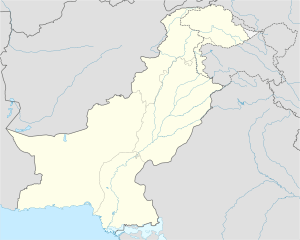Dalwal facts for kids
Quick facts for kids
Dalwal ڈلوال
|
|
|---|---|
| Dalwal Kahoon | |
| Country | Pakistan |
| Province | Punjab |
| District | Chakwal District |
| Time zone | UTC+5 (PST) |
| • Summer (DST) | +6 |
Dalwal (Urdu: ڈلوال) is a village and union council in Chakwal District, Punjab Province, Pakistan. It is part of Choa Saidan Shah Tehsil and is located at 32°42'0N 72°52'60E. Dalwal is known as an old and important town in the Kahoon area.
Contents
About Dalwal Village
Dalwal is a very old village with a rich history. It is believed to be linked to Raja Daulta Khan. The village is the headquarters of the Dalwal Union Council. It is about 9 kilometers west of Choa Saidan Shah city.
People and Culture
Most people in Dalwal are from the Janjua, Rajput, and Awan tribes. There is also a smaller group of Minhas and Bhatti families. The main religion in Dalwal is Islam, with a small number of Christian residents.
Surrounding Areas
Many smaller villages are located around Dalwal. To the west, you can find Dhok Thoha, Badshahpur, and Dhok Syedullah. Other nearby villages include Dhok Anar Khan, Bhamrot, and Wadala. To the south, there are Makkach, Nila, and Sigar.
Famous People from Dalwal
Dalwal has been home to several notable people. One famous person is Flight Lt. Cecil Chaudhry, who received the Sitara-e-Jurat award for his bravery.
History of Dalwal
Dalwal is considered one of the oldest and largest towns in the Kahoon region, both in terms of population and area.
How Dalwal Got Its Name
Local elders believe that Raja Daulat Khan, also known as Dulu, founded Dalwal. He was a descendant of Raja Javadir Khan from the Janjua family. Some people think the name "Dalwal" might come from "Dhalwal," meaning a sloping site, as much of the village is built on slopes.
Ancient Settlements and Trade
It is thought that Dalwal might have first been settled near the ruins of Jatrwal. After Jatrwal was destroyed, people moved to the current location and named it Dalwal. In the past, Dalwal was a busy trading market, similar to Chakwal and Choa Saidan Shah. Shopkeepers from the area would come here to buy goods. Salt was even transported from Dalwal to Kashmir.
Dalwal's Crafts and Growth
Historically, Dalwal was known for making high-quality shoes and boots. Decorative stone pots were also crafted here. In 1880, Dalwal had about 750 houses and a total population of 3,100 people (including Badshahpur). By the 1998 census, the population had grown to 8,527.
Education in Dalwal
Dalwal has a long history of focusing on education.
Mission High School
The Mission High School in Dalwal was started by Christians in 1900. It was the only school of its kind in Chakwal District before Pakistan became independent. Franciscan priests were involved in its early days. The school was taken over by the government in 1972 but was later returned to the Catholic community in 2000.
Early Efforts for Education
Before the Mission High School, Dalwal had a District Board Primary School. People in Dalwal wanted a middle school so their children could get a better education. In 1894, a local leader named Diwan Ho Shanak Roy tried to get a middle school built, but the request was initially turned down because Dalwal was considered a small place.
Building the School
In 1899, Raja Faizullah Khan, a chief from the area, met with a senior priest from the Catholic Mission in Rawalpindi. The priest helped him send a request to the Lord Bishop in Lahore. The Lord Bishop was moved by the request to help people get an education. Raja Faizullah Khan also donated land for the school.
In May 1899, two priests visited Dalwal to see the land. The Lord Bishop later decided that more land was needed, and Raja Faizullah Khan donated even more. Construction of the school began quickly, and the building was ready in just three months.
Facilities and Infrastructure
Dalwal is located about 720 meters above sea level. It has many modern facilities for its residents.
Public Services
The village has a reliable water supply and electricity. There is a post office and telephone services. For healthcare, Dalwal has a hospital and a veterinary center for animals.
Transportation and Roads
Dalwal has good road connections, and all its streets are paved. This makes it easier for people and goods to move around.
Education and Religion
For education, there are Girls High and Boys High Schools. There are also three seminaries for religious education and training.
Water Sources
Dalwal has eight ponds or "bins," which are important water sources. Some of the well-known ones include Jagu Wali, Dhale Wali, Ard Wali Bin, and Faqiran Wali Bin.
Mosques
Dalwal is home to 15 mosques, serving the spiritual needs of the community. Some of the notable mosques include:
- Pakki Masjid
- Athar Shahani Masjid
- Khawajgan Masjid
- Gayan Wali Masjid
- Malikan Wali Masjid
- Suku Wali Masjid
- Mistrian Masjid
- Firdous Masjid
- Saad bin Abi Waqqas Masjid
|


